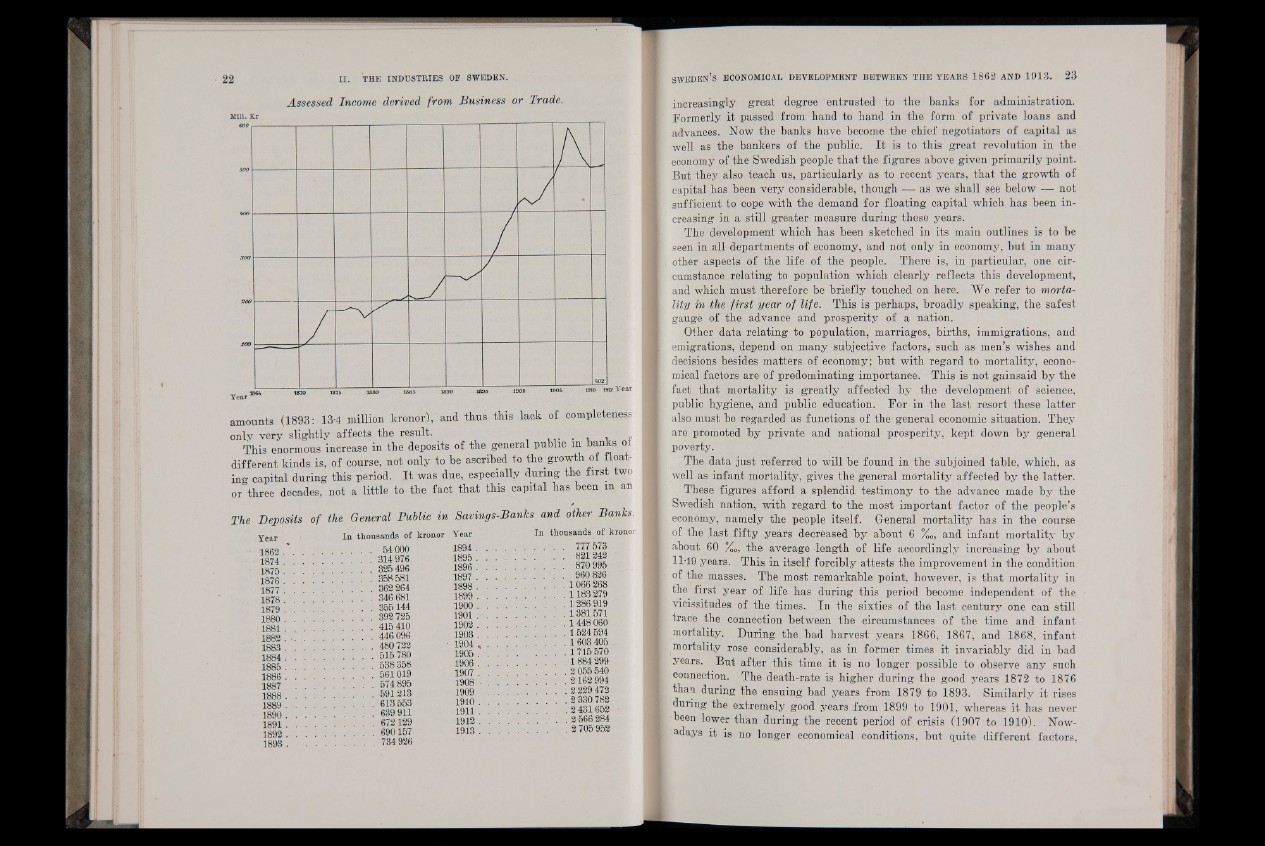
Assessed Income derived from Business or Trade.
Mill. Kr
Year
amounts (1893: 13-4 million kronor), and thus this lack of completeness
only very slightly affects the result. I
This enormous increase in the deposits of the general public U banks oi
different kinds is, of course, not only to be ascribed to the growth of floating
capital during this period. It was due, especially during the first two
or three decades, not a little to the fact that this capital has been m an
The Deposits of the General Public in Savings-Banks and other Banks.
In thousands Year of kronor Year
1862 1 ................................
1874 .................................... 314 976
1875 ....................................3 2 5 496
1876 . . . . . . 358 581
I877; ............................ 362 264
1878 ...................................... I H |
1879 ................................ 355144
1880 . ; ............................ 392 725
1881 ..................................... 415 410
1882 . -446 096
1883 ..................................... 480 722
1884 ..................................... 515 780
1885 ..................................... 538 358
1886 ..................................... 561 019
1887 574 895
1888 ..................................... 591 213
1889 ................................. 613 553
1890 ..................................... 639 911
1891 ..................................... 672 129
1892 ............................... • 690157
1893 ..................................... 734 926
In thousands of kronor
1894. . . . . . . . . . 777 573
1895 ...................1 . . 821 242
1 8 9 6 . .............................. 870 995
189 7 ................................ 960 826
1898 . 1066 268
1899 .................................... 1183 279
1900 .................................... 1286 919
1 9 0 1 : ................................ 1381 571
1902 .................................... 1448 060
1903 .................................... 1 524 594
1904 , . . . . ■ • ■ . 1603 405
1905 .................................... 1715 570
1906 .......................... 1884 299
1907 ................................... 2 055 540
1908 • ................................ 2 162 994
1909 ................................ 2 229 472
1910 ................................... 2 330 782
1911 .................................... 2 431 652
1912 . . . . . 2 566 284
1913! Hi................ 2705952
increasingly great degree entrusted to the banks for administration.
Formerly it passed from hand to hand in the form of private loans and
advances. How the banks have become the chief negotiators of capital as
well as the bankers of the public. I t is to this great revolution in the
economy of the Swedish people that the figures above given primarily point.
But they also teach us, particularly as to recent years, that the growth of
capital has been very considerable, though — as we shall see below not
sufficient to cope with the demand for floating capital which has been increasing
in a still greater measure during these years.
The development which has been sketched in its main outlines is to be
seen in all departments of economy, and not only in economy, but in many
other aspects of the life of the people. There is, in particular, one circumstance
relating to population which clearly reflects this development,
and which must therefore be briefly touched on here. We refer to mortality
in the first year of life. This is perhaps, broadly speaking, the safest
gauge of the advance and prosperity of a nation.
Other data relating to population, marriages, births, immigrations, and
emigrations, depend on many subjective factors, such as men’s wishes and
decisions besides matters of economy; but with regard to mortality, economical
factors are of predominating importance. This is not gainsaid by the
fact that mortality is igreatly affected by the development of science,
public hygiene, and public education. For in the last resort these latter
also must be regarded as functions of the general economic situation. They
are promoted by private and national prosperity, kept down by general
poverty.
The data just referred to will be found in the subjoined table, which, as
well as infant mortality, gives the general mortality affected by the latter.
These figures afford a splendid testimony to the advance made by the
Swedish nation, with regard to the most important factor of the people’s
economy, namely the people itself. General mortality has in the course
of the last fifty years decreased by about 6 %0, and infant mortality by
about 60 %„, the average -length of life accordingly increasing by about
11-19 years. This in itself forcibly attests the improvement in the condition
of the masses. The most remarkable point, however, is that mortality in
the first year of life has during this period become independent of the
vicissitudes of the times. In the sixties of the last century one can still
trace the connection between the circumstances of the time and infant
mortality. During the, bad harvest years 1866, 1867, and 1868, infant
mortality rose considerably, as in former times it invariably did in bad
years. But after this time it is no longer possible to observe any such
connection. The death-rate is higher during the good years 1872 to 1876
than during the ensuing bad years from 1879 fo 1893. Similarly it rises
during the extremely good years from 1899 to 1901, whereas it has never
been lower than during the recent period of crisis (1907 to 1910). Nowadays
it is no longer economical conditions, but quite different factors,